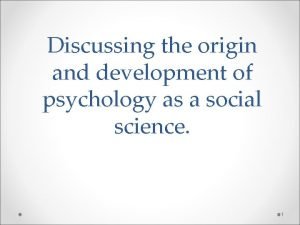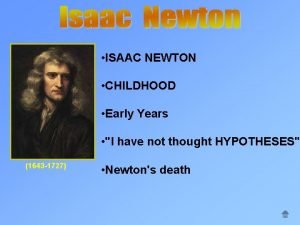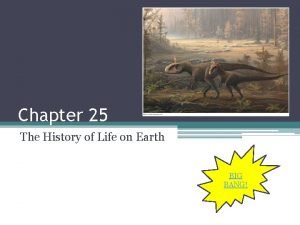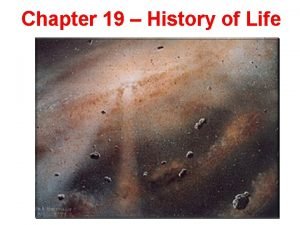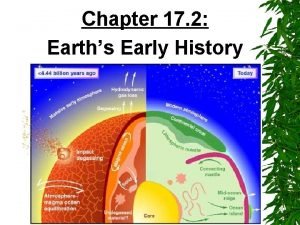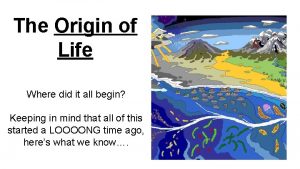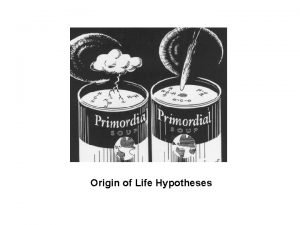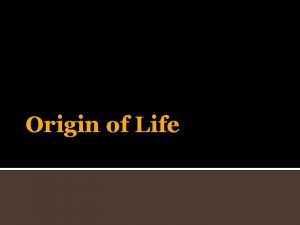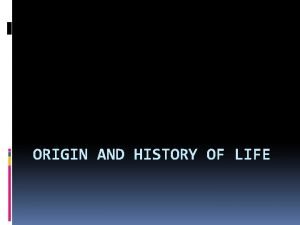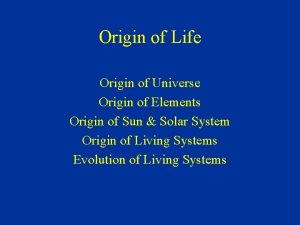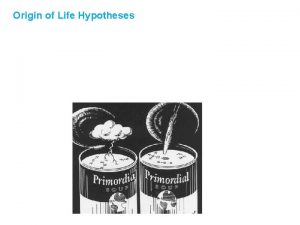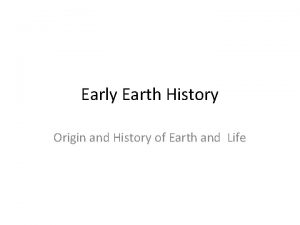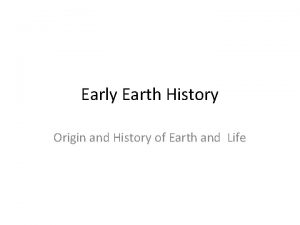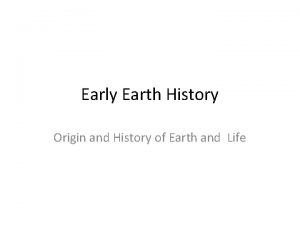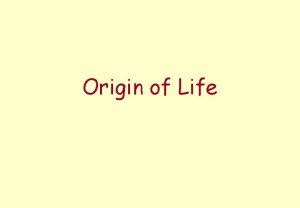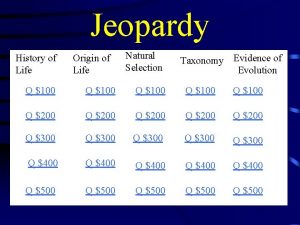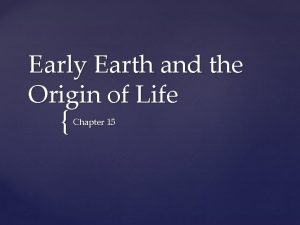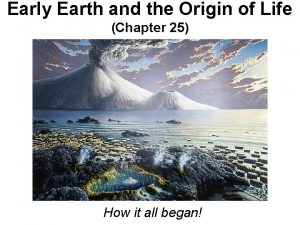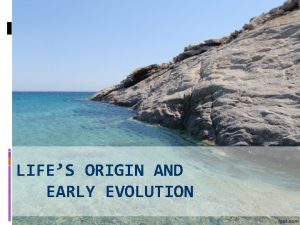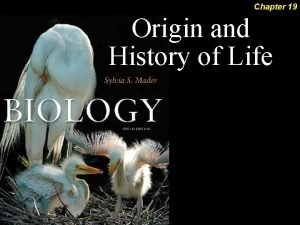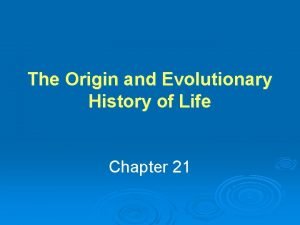The Origin and Early History of Life Chapter





















- Slides: 21

The Origin and Early History of Life Chapter 4

Outline • • Fundamental Properties of Life Origin of Life Hypotheses Chemical Evolution Cell Origin Theories – Bubble Theories Prokaryotic Cells – Archaebacteria – Bacteria Eukaryotic Cells Extraterrestrial Life 2 2

Fundamental Properties of Life • • cellular organization sensitivity growth development reproduction regulation homeostasis heredity 3 3

Origin of Life Hypotheses • • • Special creation – supernatural or divine origin Extraterrestrial origin – panspermia Spontaneous origin – life originated from inanimaterials 4 4

Reducing Atmosphere • Life most likely emerged under hightemperature conditions. – Early atmosphere is often referred to as a reducing atmosphere. § exact conditions unknown v ample availability of hydrogen atoms v very little oxygen 5 5

Origin of Life - Location • • • Ocean’s edge – bubble hypotheses Under frozen seas – problematic due to necessary conditions Deep in Earth’s crust – byproduct of volcanic activity Within clay – positively-charged clay Deep-sea vents – conditions suitable for Archaea 6 6

Miller-Urey Experiment • attempted to reproduce early reducing atmosphere and produce organic compounds from inorganic materials – hydrogen-rich – electrical discharge § succeeded in producing amino acids 7 7

Miller-Urey Experiment 8 8

Chemical Evolution • Ongoing debate concerning actual path – RNA World - Molecules could not have consistently formed without a mechanism of heredity. – Protein World - Replication would be impossible without enzymes. – Peptide-Nucleic Acid World - RNA is too unstable, thus a precursor must have existed. 9 9

Cell Origin Theories • Bubble theories – Certain molecules spontaneously form bubbles. § would serve to shield hydrophobic regions from contact with water v supports ocean’s edge scenario 10 10

Cell Origin Theories • Oparin’s Bubble Hypothesis – Primary abiogenesis - protobionts allowed chemical complexity to develop § Many different bubble scenarios have been proposed. v no agreement about composition or how the process occurred 11 11

Bubble Hypothesis 12 12

Earliest Cells • Microfossils have been found in rocks as old as 2. 5 billion years old. – resemble prokaryotes § lack nucleus of more complex eukaryotes 13 13

Archaebacteria • extreme-condition prokaryotes – lack peptidoglycan in cell walls § methanogens § extreme halophiles § extreme thermophiles – thought to have split from Bacteria 2 bya. 14 14

Bacteria • second major group of prokaryotes – strong cell walls – simpler gene structure – contains most modern prokaryotes § includes photosynthetic bacteria v cyanobacteria 15 15

First Eukaryotic Cells • Eukaryotes probably arose about 1. 5 bya. – Internal membrane-bound structures such as mitochondria and chloroplasts are thought to have evolved via endosymbiosis. § Energy-producing bacteria were engulfed by larger bacteria. v beneficial symbiotic relationship 16 16

Endosymbiosis 17 17

First Eukaryotic Cells • • Sexual reproduction – Eukaryotic cells can reproduce sexually, thus allowing for genetic recombination. § Genetic variation is the raw material necessary for evolution. Multicellularity – arisen many times among eukaryotes § fosters specialization 18 18

Extraterrestrial Life • Universe has 1020 stars similar to our sun. – Conditions may be such that life has evolved on other worlds in addition to our own. § ancient bacteria on Mars. v largest moon of Jupiter, Europa, covered with ice. Ø liquid water may be underneath 19 19

Summary • • Fundamental Properties of Life Origin of Life Hypotheses Chemical Evolution Cell Origin Theories – Bubble Theories Prokaryotic Cells – Archaebacteria – Bacteria Eukaryotic Cells Extraterrestrial Life 20 20

21 21
 Early cpr and early defibrillation can: *
Early cpr and early defibrillation can: * Origins of greek tragedy
Origins of greek tragedy History and origin of science of psychology slideshare
History and origin of science of psychology slideshare Explain methods of psychology
Explain methods of psychology Structuralist school of thought
Structuralist school of thought Isaac newton early childhood
Isaac newton early childhood Hhmi deep history of life on earth
Hhmi deep history of life on earth Section 17-4 patterns of evolution
Section 17-4 patterns of evolution Section 17-2 earth's early history
Section 17-2 earth's early history 17-2 earth's early history
17-2 earth's early history Section 17-2 earth's early history
Section 17-2 earth's early history Renaissance period floral arrangements
Renaissance period floral arrangements Early beginnings history of tourism
Early beginnings history of tourism History of floral design
History of floral design What do historians call the early period of human history
What do historians call the early period of human history Origin of life
Origin of life Origin of life
Origin of life When life gives you lemons origin
When life gives you lemons origin Hát kết hợp bộ gõ cơ thể
Hát kết hợp bộ gõ cơ thể Frameset trong html5
Frameset trong html5 Bổ thể
Bổ thể Tỉ lệ cơ thể trẻ em
Tỉ lệ cơ thể trẻ em




